
Parsley and coriander are the most commonly used herbs in kitchens worldwide. They add flavor and color to salads, soups, and various dishes.
However, their similar appearance can lead to confusion, especially when hurrying to prepare a meal.
This blog will clarify the differences between parsley and coriander, helping you identify each herb easily and understand its unique characteristics.
Whether you’re a home cook or a culinary enthusiast, this guide will ensure you never mistake one for the other again.
We’ll explore their visual distinctions, flavor profiles, and culinary uses. By the end of this post, you’ll clearly understand how to differentiate these two herbs and use them best in your cooking.
1. Visual Distinction between Parsley and Coriander
Leaf Shape
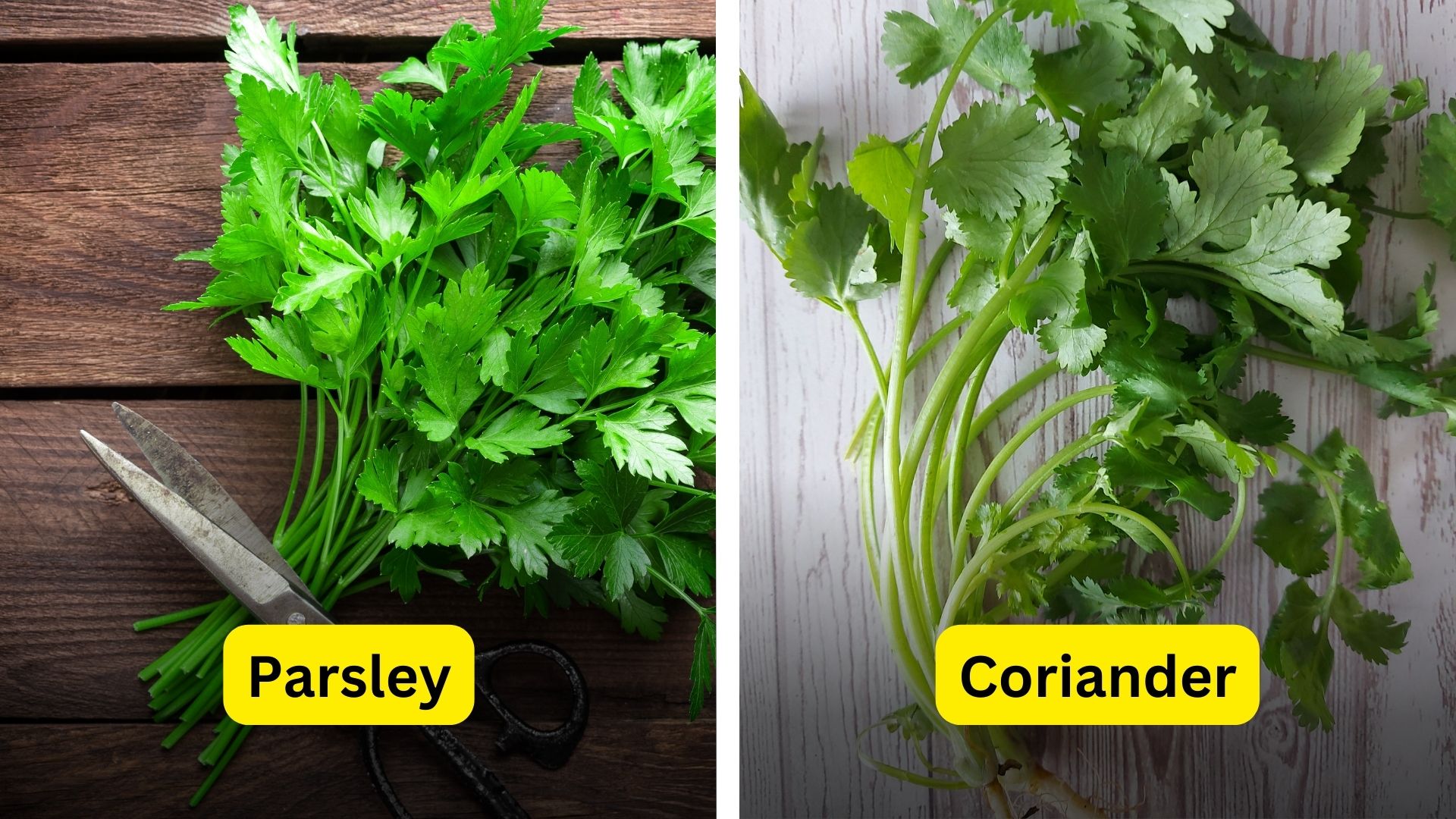
Parsley and coriander may seem similar at first glance, but their leaf shapes are distinct upon closer inspection.
Parsley leaves are pointed and jagged, resembling small, sharp-edged fans. Once familiar with its appearance, this characteristic makes parsley easy to identify.
Conversely, coriander leaves are more rounded with lobed edges, giving them a softer, more delicate appearance.
Stem Characteristics
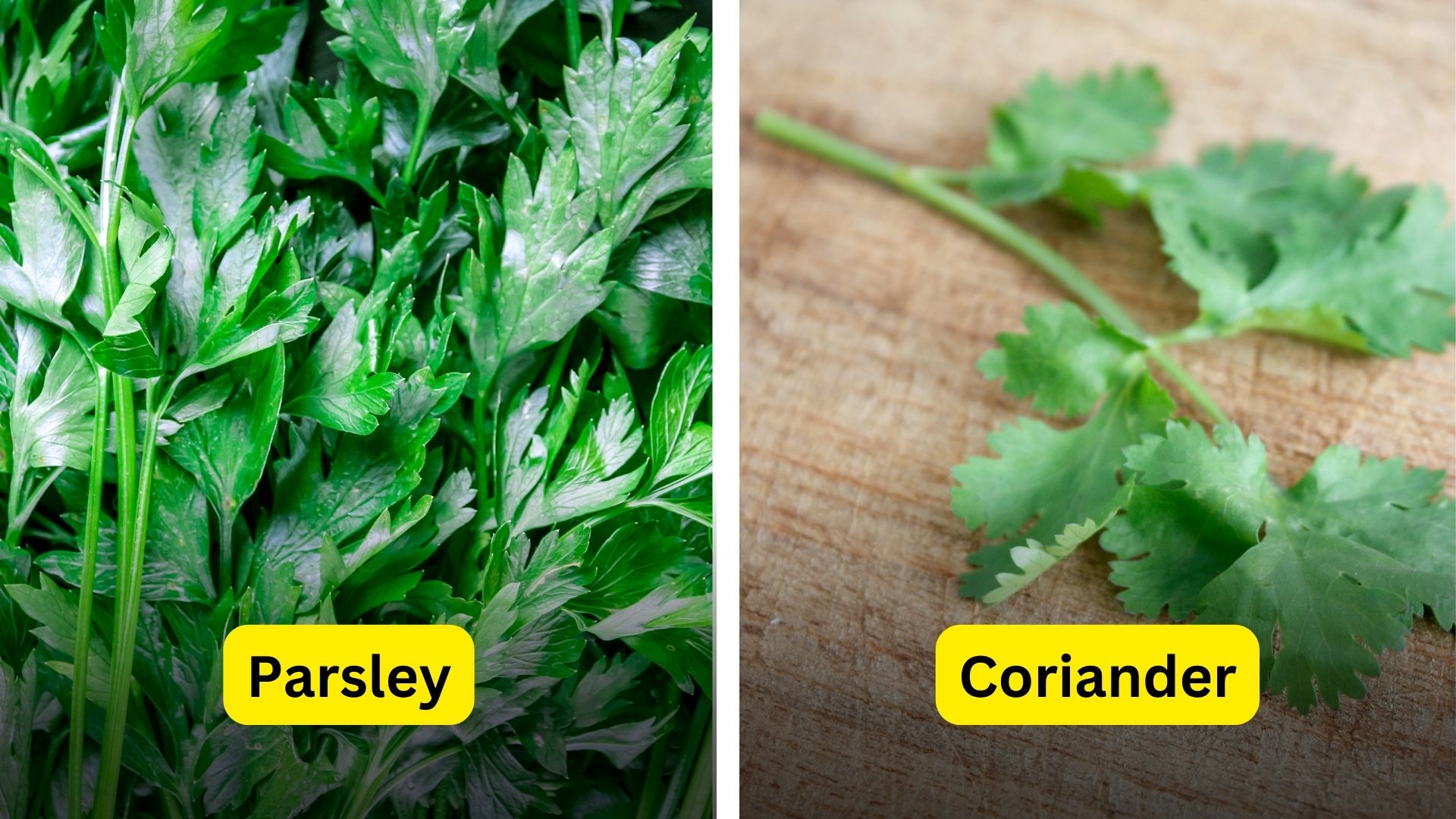
The stems of these herbs also differ significantly. Parsley’s stems are robust and elongated, often standing out with their firm structure.
They provide a sturdy base for the leaves, making them ideal for garnishing or cooking. In contrast, coriander’s stems are more delicate and thinner, reflecting the herb’s light and airy nature.
These stems are flexible and often hollow, contributing to coriander’s unique texture in culinary applications.
2. Parsley and Coriander: Taste and Aroma
Flavor Profile
When it comes to flavor, parsley and coriander are worlds apart. Parsley offers a subtle, peppery taste with a grassy undertone, making it a versatile herb that complements various dishes without overpowering them.
In contrast, coriander presents a bold, citrusy flavor with spicy undertones. This distinct taste is loved by many but can be perceived as soapy by some due to genetic variations in taste perception.
Aromatic Properties
Another key difference is the aroma of these herbs. Parsley emits a mild, fresh herbal scent, adding brightness to dishes without overwhelming other flavors.
Coriander, however, releases a strong, distinct citrus aroma that can fill a kitchen with its sharp and refreshing scent.
This aromatic quality is one reason coriander is a favorite in many global cuisines, particularly those requiring a bold, fresh flavor.
3. Plant Life Cycle: Parsley vs Coriander
Parsley
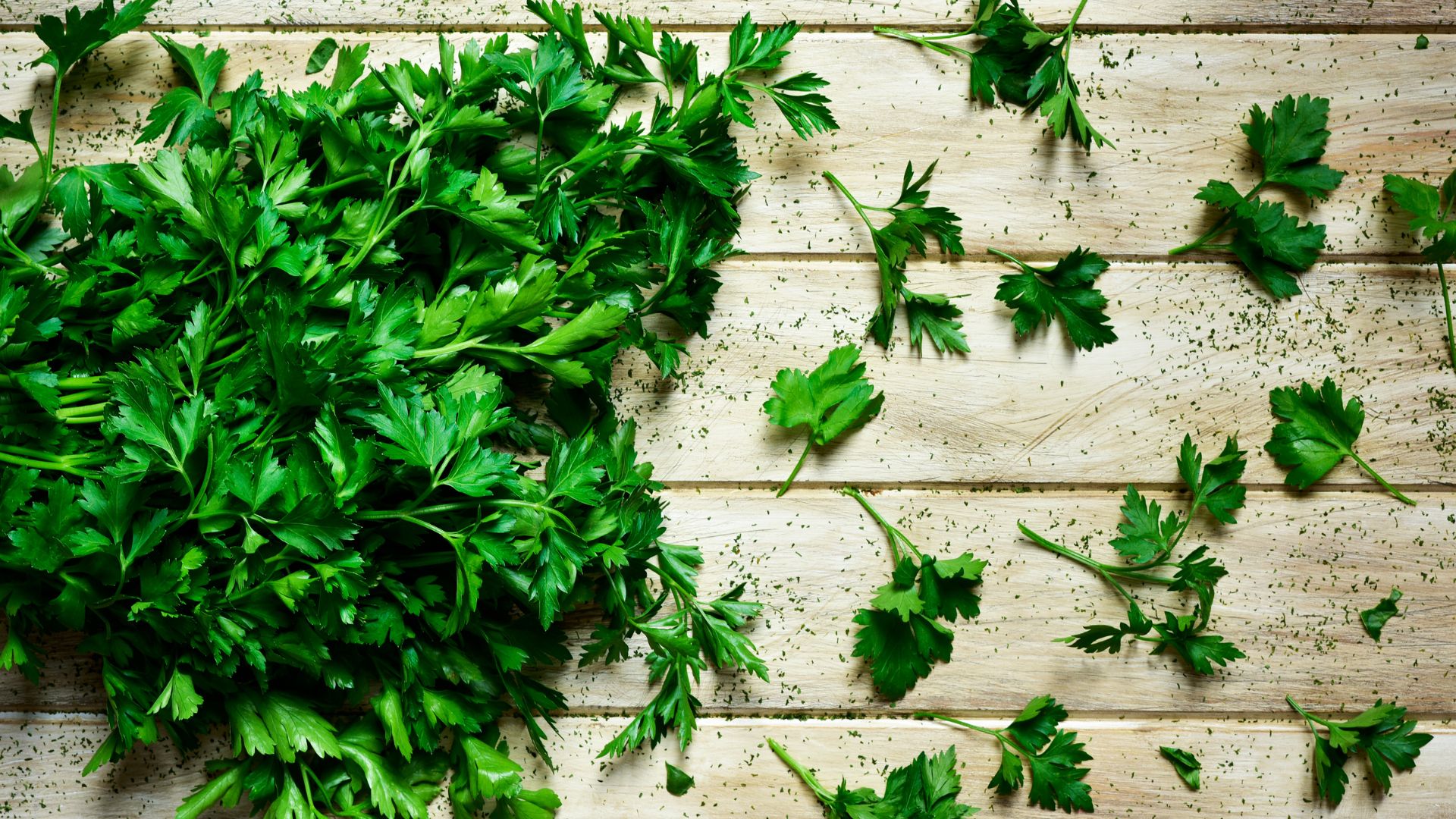
Parsley is a biennial herb that naturally completes its life cycle over two years. In its first year, parsley focuses on producing lush green leaves commonly harvested for culinary use.
The plant shifts energy toward flowering and seed production by the second year.
However, in many home gardens and commercial farms, parsley is often grown annually and harvested during its first year when the leaves are most tender and flavorful.
Coriander
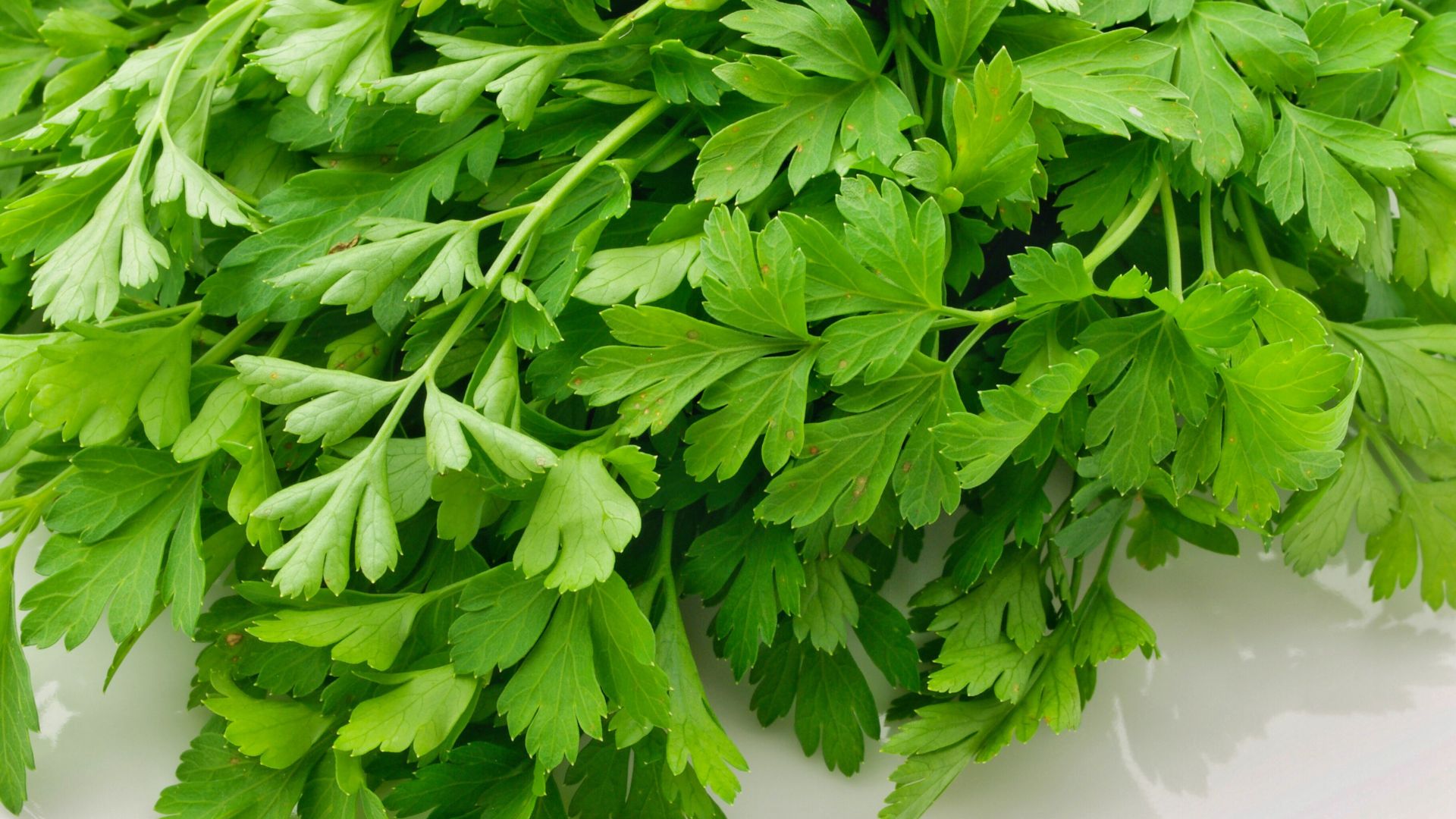
Coriander, in contrast, is an annual herb that completes its entire life cycle within a single growing season. It thrives in cool weather and produces leaves early in its growth.
As temperatures rise, coriander quickly moves to the flowering stage, producing seeds that can be harvested for use as a spice.
The rapid progression from leaf production to seed formation makes coriander a plant that requires careful cultivation timing, especially in warmer climates.
4. Parsley vs Coriander: Adaptability and Growing Conditions
Parsley
Parsley is known for its hardiness and adaptability. It grows well in various climates, making it a popular choice for gardeners and chefs.
Parsley thrives in full sun and partial shade, and its resilient nature allows it to bounce back from minor stressors, such as inconsistent watering.
This adaptability makes parsley a reliable herb for consistent harvests throughout the growing season.
Coriander
Coriander prefers cooler climates and tends to quickly bolt or go to seed when exposed to warmer conditions.
This sensitivity to temperature makes it a bit more challenging to grow, especially in regions with hot summers.
The herb’s shorter lifespan and tendency to flower early mean that it must be planted with careful consideration of seasonal temperatures.
For gardeners in warmer climates, successive planting in early spring or late summer can help extend the coriander harvest.
5. Usage of Parsley and Coriander in Dishes
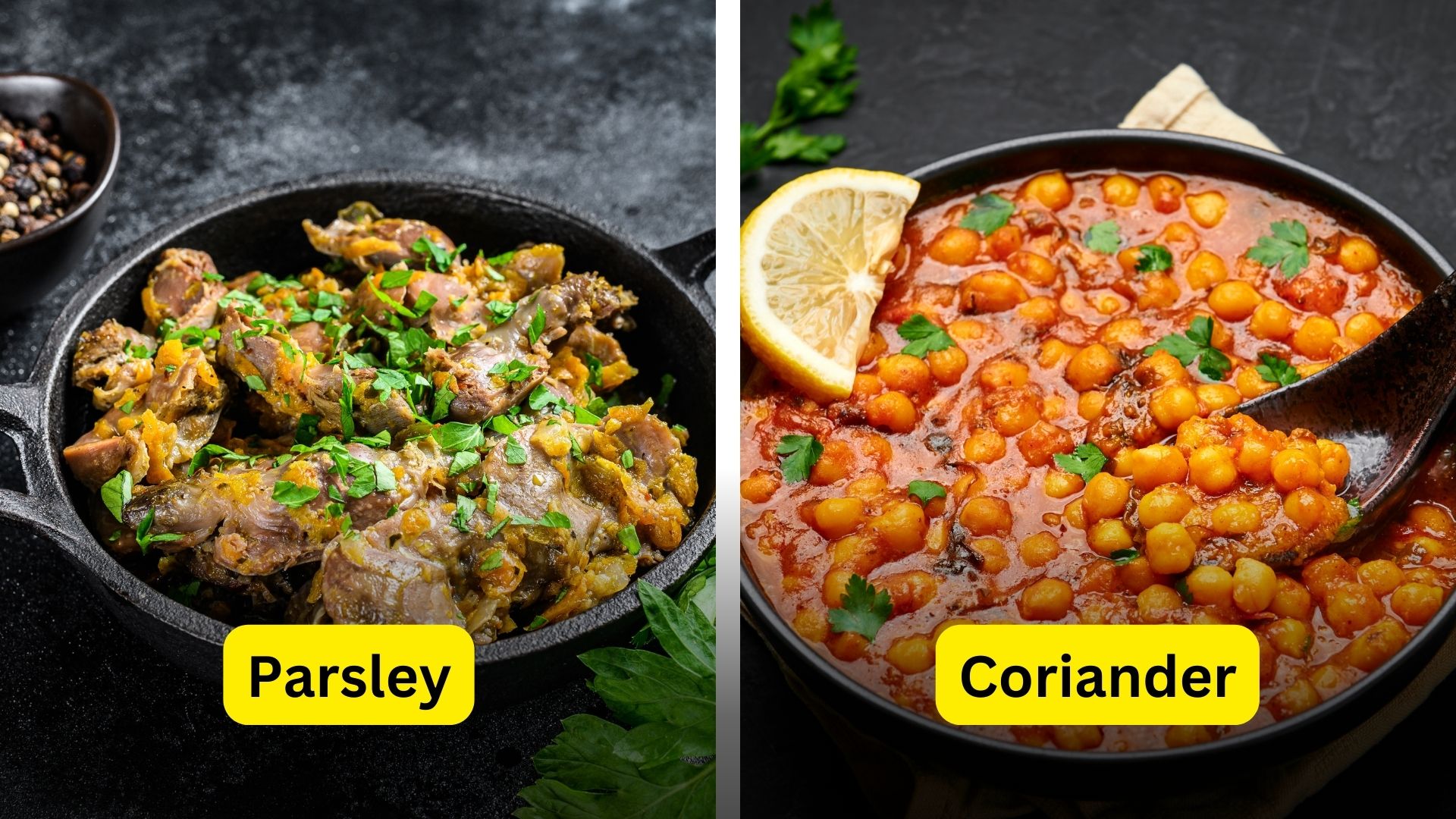
Parsley
Parsley is a versatile herb widely recognized for its role in garnishing and flavoring various dishes.
Its mild, fresh taste makes it an excellent addition to soups, stews, and salads. It adds a touch of green without overpowering the main ingredients.
Parsley is also a staple in many herb blends, such as bouquet garni and fine herbs, contributing to a balanced, herbaceous flavor profile.
Whether fresh or dried, parsley is a kitchen essential because it enhances a dish’s overall taste and presentation.
Coriander
Coriander is integral to Asian, Mexican, and Latin American cuisines, where its bold, citrusy flavor is central.
Coriander leaves add a fresh, vibrant element to salsas, curries, and chutneys, complementing these dishes’ rich, complex flavors.
The herb’s unique taste profile makes it a key ingredient in recipes that require a strong, aromatic presence, elevating the overall flavor experience.
Parsley as a Substitute for Coriander
When substituting one herb for the other, parsley can be used instead of coriander in dishes with a mild flavor.
Parsley works well in recipes that do not require the strong citrus notes of coriander, such as certain salads or light soups.
However, the substitution will result in a more subtle flavor, which might not provide the same intensity as coriander.
Coriander as a Substitute for Parsley
Coriander can also be substituted for parsley, particularly in cuisines that favor bold flavors, such as Mexican or Thai.
Its strong, aromatic qualities make it suitable for dishes that can handle its distinct taste.
However, because coriander has a more pronounced flavor, it may overpower milder dishes where parsley is typically used, so it’s important to consider the overall flavor balance when making this substitution.
6. Nutritional Value of Parsley and Coriander
Parsley
Parsley is particularly rich in vitamin K, a vital nutrient crucial to blood clotting and bone health.
Just a small amount of parsley can provide a significant portion of the daily recommended vitamin K intake, making it a beneficial addition to your diet.
This nutrient is essential for maintaining strong bones and ensuring proper blood clotting, helping to prevent excessive bleeding.
Coriander
Coriander is known for its high antioxidant content, which supports overall metabolic health. Antioxidants help protect the body’s cells from damage caused by free radicals, reducing the risk of chronic diseases.
Thanks to these protective compounds, incorporating coriander into your meals can improve metabolic function and strengthen your immune system.
7. Parsley and Coriander: Health Benefits
Parsley
Beyond its nutritional value, parsley is believed to offer several health benefits.
It is known for its potential to reduce kidney stones due to its diuretic properties, which help flush excess fluids and salts from the body.
Additionally, parsley supports digestion by stimulating the production of digestive enzymes, making it a helpful herb for maintaining a healthy digestive system.
Coriander
Coriander also boasts a range of health benefits. It may help regulate blood pressure by promoting relaxation of the blood vessels, improving circulation, and lowering blood pressure levels.
Furthermore, coriander has antimicrobial properties, which can help protect the body against certain harmful bacteria and fungi, contributing to overall health and well-being.
8. Seed Applications of Parsley and Coriander

Parsley
Parsley seeds are primarily used for propagation rather than for culinary purposes. Gardeners and farmers plant parsley seeds to grow new plants, ensuring a continuous supply of fresh parsley leaves.
The seeds are not commonly consumed or used in cooking, as the leaves are the primary part of the plant, valued for their flavor and nutritional benefits.
Coriander
Coriander seeds are a versatile spice widely used in various culinary traditions worldwide.
The seeds have a warm, earthy flavor with a hint of citrus, making them a key ingredient in spice blends such as garam masala and curry powder.
Ground coriander seeds are often used to season meats, vegetables, and sauces, adding depth and complexity to various dishes.
9. Uses of Root of Parsley and Coriander

Parsley
Parsley root, also known as Hamburg parsley, is a root vegetable that can be used in cooking similarly to carrots.
It has a slightly sweet, earthy flavor and is often added to soups, stews, and roasted vegetable dishes. Although the root is less common in everyday cooking, it is valued for its unique taste and versatility in various recipes.
Coriander
Coriander roots are highly prized for their intense flavor, particularly in Thai and Vietnamese cuisine. Their strong, aromatic quality adds depth to dishes such as curries, marinades, and soups.
They are often pounded into pastes or finely chopped to release their full flavor, making them a vital component in many traditional Southeast Asian recipes.
Summing Up
Understanding the key differences between parsley and coriander can greatly enhance your culinary skills.
While similar in appearance, these herbs offer distinct flavors and uses that can elevate your dishes.
Knowing when and how to use each herb is essential, whether adding a subtle touch with parsley or a bold flavor with coriander.
So next time you’re in the kitchen, remember these differences and let your cooking shine. If you found this guide helpful, share it with your friends and family for more tips on using herbs effectively in your recipes.

